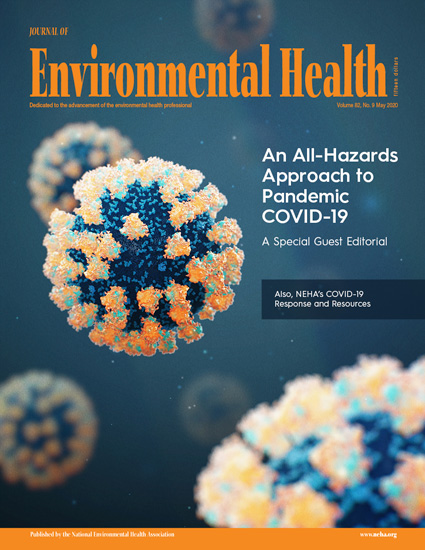尿镉浓度与 COVID-19 的严重程度和临床结果相关:一项双中心观察性队列研究
IF 5.3
2区 环境科学与生态学
Q1 ENVIRONMENTAL SCIENCES
引用次数: 0
摘要
镉和镍的暴露可导致氧化应激、诱发炎症、抑制免疫功能,因此对许多疾病的发病机制和严重程度有重大影响。严重急性呼吸系统综合征冠状病毒 2(SARS-CoV-2)感染也会引起氧化应激以及炎症和免疫反应失调。本研究旨在评估镉和镍暴露与 2019 年冠状病毒病(COVID-19)患者的严重程度和临床结果之间的潜在关联。我们对2022年6月至2023年7月期间在台湾感染SARS-CoV-2的患者进行了一项回顾性、观察性、双中心队列分析。在确诊急性 SARS-CoV-2 感染后 3 天内测量了血液和尿液中的镉和镍浓度,并分析了 COVID-19 患者的严重程度和临床结果。共对 574 名患者进行了分析,并将其分为严重 COVID-19 组(住院患者)(n = 252;43.9%)和非严重 COVID-19 组(n = 322;56.1%)。住院总死亡率为 11.8%(n = 68)。与非重度 COVID-19 患者相比,重度 COVID-19 患者年龄更大,合并症明显增多,中性粒细胞/淋巴细胞比率、C 反应蛋白和白细胞介素-6 明显更高(均 p 2.05),μg/g 的预测值最高(调整 OR 5.349,[95% CI 1.118-25.580],p = 0.036)。COVID-19早期尿镉浓度可预测患者病情的严重程度和临床结局,并与严重COVID-19的风险独立相关。本文章由计算机程序翻译,如有差异,请以英文原文为准。
Urinary cadmium concentration is associated with the severity and clinical outcomes of COVID-19: a bicenter observational cohort study
Cadmium and nickel exposure can cause oxidative stress, induce inflammation, inhibit immune function, and therefore has significant impacts on the pathogenesis and severity of many diseases. Severe acute respiratory syndrome coronavirus 2 (SARS-CoV-2) infection can also provoke oxidative stress and the dysregulation of inflammatory and immune responses. This study aimed to assess the potential associations of cadmium and nickel exposure with the severity and clinical outcomes of patients with coronavirus disease 2019 (COVID-19). We performed a retrospective, observational, bicenter cohort analysis of patients with SARS-CoV-2 infection in Taiwan between June 2022 and July 2023. Cadmium and nickel concentrations in blood and urine were measured within 3 days of the diagnosis of acute SARS-CoV-2 infection, and the severity and clinical outcomes of patients with COVID-19 were analyzed. A total of 574 patients were analyzed and divided into a severe COVID-19 group (hospitalized patients) (n = 252; 43.9%), and non-severe COVID-19 group (n = 322; 56.1%). The overall in-hospital mortality rate was 11.8% (n = 68). The severe COVID-19 patients were older, had significantly more comorbidities, and significantly higher neutrophil/lymphocyte ratio, C-reactive protein, and interleukin-6 than the non-severe COVID-19 patients (all p < 0.05). Blood and urine cadmium and urine nickel concentrations were significantly higher in the severe COVID-19 patients than in the non-severe COVID-19 patients. Among the severe COVID-19 patients, those in higher urine cadmium/creatinine quartiles had a significantly higher risk of organ failure (i.e., higher APACHE II and SOFA scores), higher neutrophil/lymphocyte ratio, lower PaO2/FiO2 requiring higher invasive mechanical ventilation support, higher risk of acute respiratory distress syndrome, and higher 60-, 90-day, and all-cause hospital mortality (all p < 0.05). Multivariable logistic regression models revealed that urine cadmium/creatinine was independently associated with severe COVID-19 (adjusted OR 1.643 [95% CI 1.060–2.547], p = 0.026), and that a urine cadmium/creatinine value > 2.05 μg/g had the highest predictive value (adjusted OR 5.349, [95% CI 1.118–25.580], p = 0.036). Urine cadmium concentration in the early course of COVID-19 could predict the severity and clinical outcomes of patients and was independently associated with the risk of severe COVID-19.
求助全文
通过发布文献求助,成功后即可免费获取论文全文。
去求助
来源期刊

Environmental Health
环境科学-公共卫生、环境卫生与职业卫生
CiteScore
10.10
自引率
1.70%
发文量
115
审稿时长
3.0 months
期刊介绍:
Environmental Health publishes manuscripts on all aspects of environmental and occupational medicine and related studies in toxicology and epidemiology.
Environmental Health is aimed at scientists and practitioners in all areas of environmental science where human health and well-being are involved, either directly or indirectly. Environmental Health is a public health journal serving the public health community and scientists working on matters of public health interest and importance pertaining to the environment.
 求助内容:
求助内容: 应助结果提醒方式:
应助结果提醒方式:


